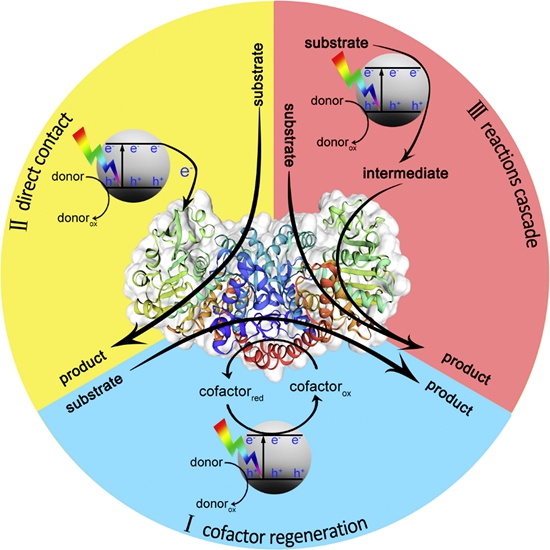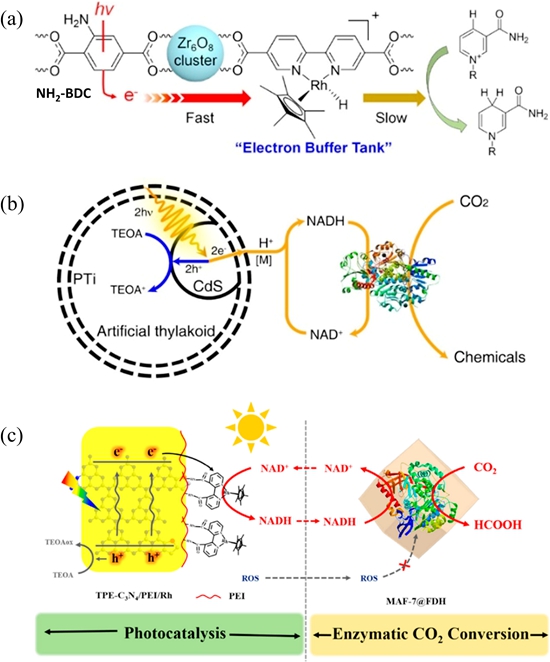Photocatalyst-enzyme Hybrid Systems for Light-driven Bio Transformation
Recently, the Innovation Team of Food Nutrition and Functional Factor Utilization of Institute of Food Science and Technology (IFST), has given insight into this research field by classifying the existing photocatalyst-enzyme hybrid systems into three section based on different hybridizing modes between photo- and enzymatic catalysis, and unlocks non-native new catalytic function of enzymes and expand the repertoire of enzymatic reaction. The relevant research results were published in the journal Biotechnology Advances (IF: 14.227) with the title “Photocatalyst-enzyme hybrid systems for light-driven bio transformation”.
Enzymes catalyse target reactions under mild conditions with high efficiency, as well as excellent regional-, stereo-, and enantiomeric selectivity. Photocatalysis utilises sustainable and environment-friendly light power to realise efficient chemical conversion. By combining the interdisciplinary advantages of photo- and enzymatic catalysis, the photocatalyst-enzyme hybrid systems have proceeded various light-driven biotransformation with high efficiency under environmentally benign conditions. According to their understanding of electron transfer from photocatalyst to enzyme, the construction schemes of the photocatalyst-enzyme hybrid systems are classified into two modes: the cofactor-mediated mode and the direct contact-based mode. In cofactor-mediated hybrid systems, cofactors act as reducing equivalents to shuttle electron transfer from the photocatalyst to the enzyme. In the direct-contact mode, the photocatalyst binds to the enzyme to enable direct transfer of photo-induced electrons to the catalytic active sites, or it transfers electrons to the catalytic active sites via redox active cofactors in enzymes. Besides discussing the cofactor-mediated and direct contact-based modes, a novel reaction cascade mode is reviewed. Compared to the first two modes that involve different electron transfer pathways, reaction cascades demonstrate a means of integrating photocatalysis with enzymatic catalysis by using an intermediate. This review discusses the three models in detail, while the authors focus on recent advances and strategies in the construction and optimisation of the catalytic efficiency and performance of photocatalyst-enzyme hybrid systems. They also discuss the pros and cons of various photocatalysts used in hybrid systems. In particular, the progress in modifying materials to suppress electron-hole recombination and promote electrons output are reviewed. In addition, they focus on the delicate design strategies in enhancing electron transfer efficiency across the interfaces between photocatalysts and enzymes, such as integrating an electron mediator with the photocatalyst, or creating a ‘hardwire’ between the photocatalyst and the distal iron-sulphur cluster to shorten electron transfer distance. Moreover, they review the strategies used to address the incompatibility between biotic and abiotic components. Finally, for the future of this field, they provide perspective that we should focus on protecting enzymes while establishing an energy/substrate highway in the photocatalyst-enzyme hybrid, and that further development in protein engineering should be also required.
This paper was co-published by the IFST and Tianjin University, researcher Wang Fengzhong and researcher Song Hao as co-corresponding authors. The work was financially supported by the Central Public-interest Scientific Institution Basal Research Fund (Y-2017PT43-10), the National Key Research and Development Program of China (2018YFA0901300), and the National Natural Science Foundation of China (32071411, 21621004).
Link to the paper: https://doi.org/10.1016/j.biotechadv.2021.107808

Scheme 1. The schematic illustration of three modes of photocatalyst-enzyme hybrid systems.

Fig. 1. Strategies for enhancing overall performance in photocatalyst-enzyme hybrid systems.
By Sun Jing (sunjing@caas.cn)
-
 Apr 18, 2024Opening Ceremony of the Training Workshop on Wheat Head Scab Resistance Breeding and Pest Control in Africa Held in CAAS
Apr 18, 2024Opening Ceremony of the Training Workshop on Wheat Head Scab Resistance Breeding and Pest Control in Africa Held in CAAS -
 Apr 03, 2024IPPCAAS Co-organized the Training Workshop on Management and Application of Biopesticides in Nepal
Apr 03, 2024IPPCAAS Co-organized the Training Workshop on Management and Application of Biopesticides in Nepal -
 Mar 28, 2024Delegation from the School of Agriculture and Food Science of University College Dublin, Ireland Visit to IAS, CAAS
Mar 28, 2024Delegation from the School of Agriculture and Food Science of University College Dublin, Ireland Visit to IAS, CAAS -
 Mar 25, 2024Director of World Food Prize Foundation visited GSCAAS
Mar 25, 2024Director of World Food Prize Foundation visited GSCAAS -
 Mar 20, 2024Institute of Crop Sciences (ICS) and Syngenta Group Global Seeds Advance Collaborative Research in the Seed Industry
Mar 20, 2024Institute of Crop Sciences (ICS) and Syngenta Group Global Seeds Advance Collaborative Research in the Seed Industry
